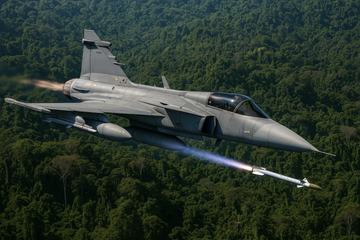In late July 2025 the Royal Thai Air Force (RTAF) ended a decades‑long record for one of Europe’s most export‑successful fighters. On 26 July 2025 the RTAF dispatched two Swedish‑built JAS‑39C/D Gripen jets together with two U.S.‑made F‑16A/Bs to strike Cambodian artillery positions along the contested border near Phu Ma Kua and Ta Muen Thom temple. The strike was carried out after Cambodian forces had positioned rocket launchers and artillery in those areas and used them to bombard Thai villages, causing numerous civilian and military casualties. Thai authorities said the attackers placed their weapons on the temple site to shield them from counter‑fire, but the RTAF decided a precision strike was necessary to stop continued shelling.
First Combat Use of the Gripen
Although the Gripen has been in service since the early 1990s and exported to several countries, it had never fired in anger. The July operation changed that. At least two Gripen jets joined the mission and employed GBU‑12 laser‑guided bombs against artillery sites. All aircraft returned safely, and Thai officials confirmed that the combined F‑16/Gripen flight successfully neutralized the targets. Aviation Week’s Chen Chuanren reports that imagery circulating online indicates the use of Mk 82‑class general‑purpose bombs, possibly equipped with a GPS‑guided kit. Whatever the exact munition, the sortie marked the first ever combat use of the Gripen ending its status as the last Western fourth‑generation fighter never to have seen combat.
Why Thailand Used It
The RTAF’s decision to field the Gripen reflects both operational necessity and long‑term modernization goals. Cross‑border clashes flared on 24 July after weeks of tension and a May incident that left a Cambodian soldier dead. Cambodian forces escalated by firing rockets and mortars into Thailand’s Surin Province. Thailand responded with air and ground forces; by 26 July it launched retaliatory air operations involving F‑16s and Gripens. A formal statement from the RTAF said Cambodian weapons positioned at Phu Ma Kua and Ta Muen Thom had to be destroyed to stop attacks and that “all four RTAF fighter jets safely returned to their bases”.
The mission also showcased the RTAF’s network‑centric capabilities. Thailand’s Gripens are integrated with Saab’s Erieye Airborne Early Warning and Control (AEW&C) system and command‑and‑control nodes, enabling real‑time data sharing and coordinated attack profiles. Army Recognition notes that the Gripen’s combat configuration includes PS‑05/A pulse‑doppler radar, digital fly‑by‑wire controls and a wide array of weapons. During the 26 July mission, Gripens flew coordinated attack profiles using real‑time data feeds to deliver surgical strikes with minimal collateral damage.
Fleet and Modernisation Plans
Thailand ordered its first six Gripen C/Ds in 2007 and a second batch of six in 2008; deliveries began in 2011. As of 2025 the RTAF operates eleven Gripens (one was lost in a 2017 crash), and the jets are based at Wing 7 in Surat Thani.. They sit alongside around 50 F‑16s and older F‑5 Tigers, forming a multi‑sourced fighter fleet. Thailand plans to upgrade its F‑16s to the Viper standard and expand its networked capabilities. In June 2025 Bangkok signed a contract for twelve new JAS‑39E/F Gripens, with the first four to be ordered later this year. These next‑generation aircraft will feature Raven ES‑05 active electronically scanned array (AESA) radar, an infrared search‑and‑track system and compatibility with the MBDA Meteor beyond‑visual‑range missile. Analysts expect the upgrades to give Thailand a significant advantage in long‑range air‑to‑air engagements.
Regional Impact and Significance
The Gripen’s combat debut carries broader implications. The Thai‑Cambodian border dispute has been simmering for decades and is linked to contested highlands and ancient temples, sometimes called the “Emerald Triangle.” Cambodia’s military lacks dedicated combat aircraft and relies on artillery and rocket systems. In contrast, Thailand now demonstrates the ability to deliver rapid, precise air‑strikes with integrated fighters and drones. Defence Security Asia observes that Thai armed drones dropped mortar bombs on Cambodian rocket launchers during the same period, highlighting a shift toward high‑tech, multi‑domain warfare.
The successful deployment of the Gripen sends a message both domestically and abroad. It underscores Thailand’s determination to defend its sovereignty and may strengthen the Gripen’s appeal on the export market. Swedish maker Saab has been seeking new buyers; besides Thailand and Brazil, potential customers include Colombia and Peru. By combining Swedish fighters, U.S. F‑16s and domestically built drones, the RTAF demonstrated a modern, integrated approach to air combat. While the Thai‑Cambodian clashes remain a dangerous flashpoint, the first combat outing of the Gripen has already altered perceptions of the aircraft and signalled a new era of airpower in Southeast Asia.
